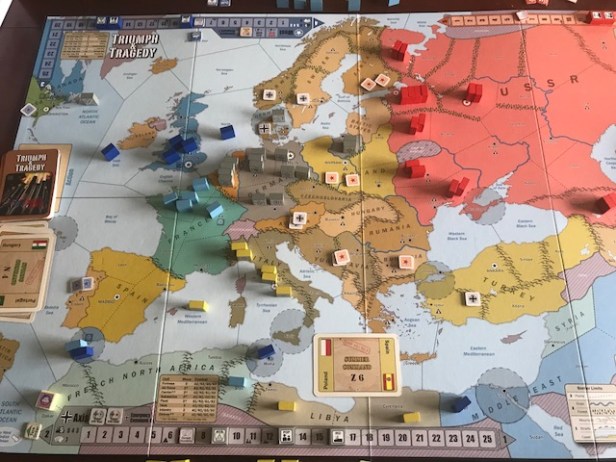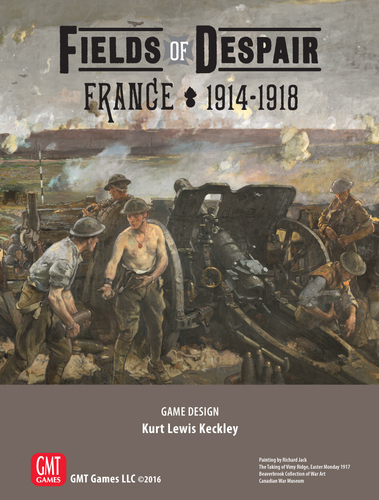Not toy blocks. Not concrete building blocks. Not blocks of cheese. These blocks represent units on the board and this is a genre of wargames that has always fascinated and interested me. A block wargame is a type of game in which each combat unit is represented by a small rectangular or square wooden block. The block stands on edge with the unit information only printed on one side facing its owner and a blank side facing the opponent. The allure to me of this genre of wargames is the Fog of War aspect that you get from not knowing exactly what you are attacking or are being attacked by until that moment when you reveal the units. This creates some really tough decisions about how to attack and where and will lead to some gaffs form time to time as you end up going full bore realizing after the fact that you overcommitted because they only had smaller value blocks and now you are out of position to follow this move up on the battlefield. Blocks make for a really great time and we have played some really good games in this genre. Here are my favorite volumes and I am sure your tastes will differ from mine.

3. Richard III: The Wars of the Roses from Columbia Games
This block wargame from Columbia Games covers the Wars of the Roses in English history over 3 scenarios, each lasting only about 30-45 minutes, so you’re able to play either just one scenario that’s short, and can be bashed out quickly, or play the protracted campaign across all 3 scenarios in about 90-120 minutes, which for a wargame is a real sweet spot as many wargames tend to weigh in at 3+ hours.
The game play in this one is actually very straight forward. It’s a Card Driven Game, but the cards aren’t extremely complex, as most of them just have a single action point allowance on them, with a few exceptions with special events, but those are very self explanatory. You use your AP’s to recruit new blocks in open or friendly areas, or to move groups from county to county, and really that’s about it. Movement is restricted by the color of the county boundary, so sometimes you have to do a bit of maneuvering and staging in order to get the battles that you’d like, but mostly you just move one or two spaces.

Combat is a series of die rolls that determine hits and you reduce block strength much like other games. The Fog of War from not seeing the values of blocks until combat is something I’m a big fan of, because it keeps the game uncertain from a decision stand point. You might find that four blocks look scary to attack, but it turns out many of them are reduced or weaker units. Then you face the dilemma of having over committed and ask yourself could I have split my armies more effectively? All of which makes for an excellent game. These games from Columbia Games are all very similar in their execution and mechanics and all bring a really great and quick playing experience to the table for anyone that is new to block wargames. This game probably holds down this spot on my list as it was my first block wargame and I have always held it in a place of revered awe as it opened my horizons.
2. Triumph & Tragedy: European Balance of Power 1936-1945 from GMT Games

Triumph & Tragedy is a geopolitical strategy game, which covers the competition for European supremacy during the period of 1936-1945 between the ideologies of Capitalism (the West), Communism (the Soviet Union) and Fascism (the Axis). It has diplomatic, economic, technological and military elements, and can be won by gaining economic hegemony or technological supremacy (A-bomb), or by vanquishing a rival militarily by controlling several capitals or sub-capitals. If you don’t know, the game is designed as a 3-player game where each player controls one of the major countries of the time, including the USSR, the Axis (Germany and Italy) and the West (Great Britain and the USA). The only difficulty I have with the game is finding 3-players that have 4-5 free hours.

Players use Action Cards to influence various countries though Europe in an attempt to bring them into their fold to gain Population or Resources. The Action Cards are also used to issues Commands such as moving a certain number of blocks on the board during the season that is called out on the card. The seasons are either Spring, Summer or Fall.
The game goes from 1936-1945 at which time the game will end and the victor will be determined by their total victory points. But, the first few years of the game is a buildup to the ultimate war where each side is trying to influence countries for the purpose of increasing their economy and production, while also building up their military forces in the form of block units, to either preemptively attack or to defend their nations. In our play, the first 3 years were spent battling over control of various countries while slowly building up the military forces needed to wage war.

Combat is really pretty straight forward as each unit is assigned a certain fire priority and to hit value against different targets. Infantry are the best fighters but they go near the end so you really have to have a good mix of unit types. Tanks hit on a 2 or less, which is one less than Infantry. But, tanks have greater movement and can be used to hit hard and fast. Each unit can take a certain amount of hits based on the number of pips on the block. One of the things that I liked about the design and its use of blocks was that most units are different for each country. For example, German Infantry have 4 steps while Russian Infantry only have 3. The unit type also determines the order of fire, for example Planes fire before Armor which fires before Infantry. So your troops can be significantly weakened before they get their first shot in. This gives some advantage to combined arms attacks, but Infantry is the workhorse in the game. Combat lasts until all units have fired in a given round and if there are units left, the battle is over for that round and must be taken back up with another Command Card in a later season. Proper planning will ensure that your battles are in your favor but you must always plan for the luck of the dice and have a backup plan. This is one of the elements that I really liked in the game.
I really enjoyed Triumph & Tragedy as it was fun and I thought that the combat system was very well done and took advantage of the blocks very well. I also really liked the fact that naval units are not necessarily held in the sea but should be placed on the land as a form of deception to the other player. These naval units do not participate in those ground combats but it hides your true power in many ways and I really like the Fog of War and deception element of this game. I also really like how the military buildup in the game is hidden as you don’t declare what you buy each round but simply up tick your blocks on the board. These elements make this one a fun game filled with surprises.

1. Fields of Despair: France 1914-1918 from GMT Games
Fields of Despair uses a very unique and revolutionary block system designed to maintain the confusion and uncertainty of the Fog of War throughout the entire game. The reason that I consider this system revolutionary is that in most block games, the combat values of individual blocks usually range from one to four, so as you scan the battlefield and after a quick calculation in your head you can come up with a pretty good guesstimate of what force power is arrayed against you, while in Fields of Despair the combat value of blocks ranges from zero (dummy blocks) all the way to a maximum of twenty. This difference in value ranges alone has completely changed the block wargame and has created a very strategic game that can be quite deceptive and difficult to play well. The reason for this deception is that you can build up one block in a hex to 20 when in other block games this would require 4 or 5 blocks that have tipped your hand and help your opponent to gauge your strategy and react more effectively to counter that. But, this deception does have its limits as air reconnaissance, one of the best parts of the design, allows players to scout out the strength of units and remove that deception. But, you cannot simply scout with no opposition as your opponent can place his air units in that hex you are scouting to initiate aerial dogfights that will ruin your recon attempt.

Movement in the game, while fairly straightforward and simple, can be used as a deceptive tool as well in addition to the use of dummy blocks. Players are allowed to “make change” during the movement phase, which means a larger block can be broken apart into 2 separate blocks or can even be done in reverse by consolidating a few smaller blocks into a larger force. So after the movement phase, you will not be 100% confident in your enemy’s strength and will have to sometimes just throw your hesitancy out the window and attack.
The Fog of War also isn’t lost after first contact with the enemy. Blocks remain hidden even when enemies occupy the same hex and stay hidden until one player decides to allocate an air squadron for reconnaissance or sends his men across no man’s land to attack.
For these reasons, Fields of Despair is by far my favorite block wargame as it uses so many aspects that are a perfect fit with blocks, including deception in movement and deception in the makeup of your forces. Such a great use of blocks and I highly recommend this game.
Those are my favorite block wargames. Please share which ones you like the best and thank you for reading.
-Grant

Richard the Third in Third place!? Can I squeeze one more game onto Santa’s list?
Great post as usual Grant!
LikeLiked by 1 person
I can understand one of three games must be on Columbia Games, or two. TaT and FoD from gmt, are great games, but RIII, the War of Roses? Really. Columbia has a lot of better games in my opinion, in the same dificutlty range, and same play’s time. Now I am thinking in Julio Cesar, or Eastfront II, or maybe Rommel in the Desert. But, finally everyone has his opinion. Nice to read you.
LikeLiked by 1 person
I just have enjoyed Richard III a lot. Also to me a lot of Columbia’s games are similar in their rules and use of blocks so this third spot could hold most any of them. I consider Pacific Victory here or Combat Infantry but just felt better about Richard III. Thanks for your comment and understanding that everyone has a different opinion.
LikeLike
Ooooh, no Sekigahara? Interesting.
LikeLike
Great list! Love the top two games!
LikeLiked by 1 person
I’ve never played a wargame with someone in person but these two are at the top of my list to play.
LikeLiked by 1 person
Have you tried black swan?
LikeLike